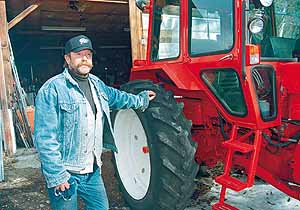| Late in
March, the Farm Bureau called a meeting in Okanogan that drew
more than 800 irate people, said Darlene Hajny, Farm Bureau
spokeswoman.
Hajny said the rules hold private landowners
to the same road maintenance standards as those of the
Department of Natural Resources. Any road condition that hurts
fish passage and stream quality has to be rectified at the
landowner’s expense.
For hay farmer Kim Maltais the road issue ties
in with another controversy. For more than a year, Maltais has
been building opposition to the Twin Creeks Coordinated Resource
Management project.
The collaborative project intends to make two
Methow tributaries, Beaver and Frasier creeks, accessible to
fish. The first phase replaces diversion dams with weirs, with
much of the funding coming from the Natural Resources and
Conservation Service.
As president of the Beaver and Frasier Creek
Water Users Association, Maltais doesn’t object to irrigation
upgrades. There are 11 major diversions of the creeks, he said,
conceding that some of the ditch operations could be improved.
What Maltais fears is “a ruse.”
His suspicions were fueled when he found a
document he feels the conservation district should have
submitted to water users at the start of the CRM process. It’s
a memorandum of understanding signed by the governor and
government agencies including NRCS. One clause can be
interpreted as an agreement by water users to have their water
rights subjected to target stream flows - if they accept federal
money for irrigation upgrades.
Maltais conceded that the wording doesn’t
precisely spell that out, however, nobody from the government is
assuring water users of anything, especially not in writing.
“We feel we’re in jeopardy,” Maltais
said. “We want some certainty.”
Enter the RMAP regs. Once again, Maltais sees
it as a hidden clause trap. The foundation for the regs was laid
back in 1999 when the Legislature passed HB2091.
But since the Forest Practices Board came out
with specifics last year, land-management agencies have been
quiet about the new rules, despite the fact that the regs could
entail costs so high as to put small farmers like Maltais out of
business.
Hajny adamantly said she first heard about
RMAP regs at a small DNR meeting on another topic.
“There were only 10 or 12 people there aside
from agency personnel. DNR sprang this RMAP business on us at
the end of the meeting. They kind of tacked it on. I said,
‘Hey, what’s this?’ They told us they want us to sit down
at the table with individual landowners. I said, ‘This is
something that needs to get out to everybody.’ ”
The Farm Bureau meeting attendance surprised
Hajny.
“It was the largest Farm Bureau meeting
I’ve ever been to in Okanogan. We had to set up extra
bleachers and people still had to stand.”
Before the meeting was called, Hajny did some
research The impact of the RMAP regs could be enormous.
“Just putting in one culvert according to
official specification runs $10,000 to $20,000,” she said. One
DNR document cites an overall estimated cost to private
landowners of $375 million.
Maltais said the RMAP regs are another example
of private property rights erosion. The basis for the regs, he
believes, “is science with an agenda.”
Hajny predicts “landowners will be standing
up to this.”
|
